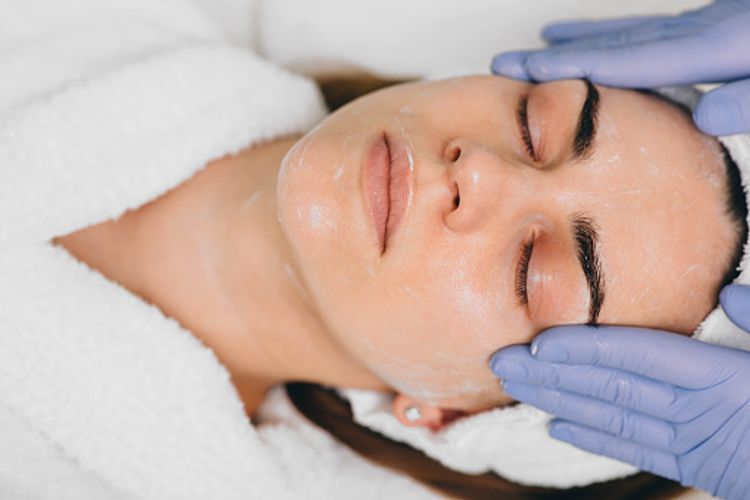Lactic acid effectively hydrates the skin, while glycolic acid brightens and firms the skin. Have you heard of mandelic acid, though? Even though mandelic acid isn’t as well-known as glycolic and lactic acids, it has its own set of benefits for the skin that you should be aware of. In this article, we’ll go over exactly what mandelic acid is and why you should use a mandelic acid peel.
What is Mandelic Acid?
Mandelic acid belongs to the alpha hydroxy acid family of chemical compounds (AHAs). The name comes from substituting a carboxylic acid (-COOH) on the adjacent carbon in the alpha position with a hydroxyl group (-OH). AHAs can be synthesized or derived naturally from fruit and milk sugars. Mandelic acid, for example, can be extracted from natural sources such as apples, bitter almonds and wild cherries.
Does Mandelic Acid Peel Skin?
Since mandelic peels are mild, they do not normally result in the typical skin peeling effect. The peel’s effects, however, are still present. For the first week, refrain from using scrubs or active creams. It is suggested that you use good sunscreen and specialized post-peel creams.
The skin is cleansed before the mandelic acid peel and then a toner is applied to remove any remaining natural oils. This degreasing process ensures the peel’s effectiveness on the skin. After applying the skin peel with gentle brush strokes, it should be left on the skin for 5 to 10 minutes.
In general, you do not experience any sensations. After five minutes, however, the peel begins to feel warm and tingly. You might notice that your skin is more irritated. Your skin will feel normal after applying the moisturizing cream.

How Often Can I Use Mandelic Acid Peel?
Everyone’s skin reacts differently to AHAs and other exfoliating skin ingredients, regardless of how gentle mandelic acid is for the skin. If you have sensitive skin, the best way is to incorporate mandelic acid gradually.
Mandelic acid peels are primarily for Treating Rosacea and sensitive skin types, so this is a peel we only do in the office and it’s not typically recommended for at-home use. The treatment is usually done in a series of three sessions spaced one month apart.
Remember that mandelic acid exfoliates the skin, making it more sensitive to sun exposure. Apply a daily sunscreen with an SPF of 30 or higher daily to protect your skin from free radicals and further damage.
Only a dermatologist or qualified provider should use higher strength concentrations, such as 40% or more. People with cold sore-prone skin should have the peel performed by a dermatologist, as it can cause outbreaks; your dermatologist can prescribe antiviral medications to prevent this.
How Long Can Mandelic Acid Be Left On?
Before applying anything else, the mandelic acid product on the skin for about 20 minutes. This may appear to be a long time, but because mandelic acid penetrates the skin more slowly, it takes longer to reach the areas where it is needed.
This may differ slightly depending on the mandelic acid-containing formula used. Exfoliating toners and serums are the most commonly used products. Both products stay on the skin for different amounts of time, determining how long you must wait before you can resume your skincare routine.
This is also important to remember when looking for the best product formula for your skin type. Exfoliating toners, for example, are ideal for those with dry skin that is prone to sensitivity because toners do not stay on the skin for an extended period of time.
How Long Does Mandelic Acid Peel Take to Work?
Once cell turnover kicks in and the acid starts to resurface your skin, you can expect to see initial results like smoother skin within a few days.
Breakouts can be reduced in as little as 1-2 weeks and stubborn dark spots can fade in as little as 4-8 weeks. It’s worth noting that the results will improve if you’re consistent and apply SPF every morning.
Your skin will improve immediately and continue to improve for a week. Your skin will be softer, smoother, and brighter. Peels continue to improve the situation, and a series of peels is recommended for acne and pigmentation before seeing any improvement. Peels every two weeks are beneficial if tolerated.
Picking out the right peel for your skin starts with choosing a trusted skin specialist. Skin Cancer and Surgery Center of NJ is an independent doctor-based medical clinic, so you can rest assured that your skin is in good hands. We have the knowledge and experience to treat more complex skin issues. Additionally, our Chemical Peels in NJ are completely safe and effective. Contact us with any of your skin concerns.

